12 Best SolarWinds Alternative Tools
As an IT enthusiast, I've explored and handpicked the top 12 SolarWinds alternatives:
- Nagios - Best for comprehensive infrastructure monitoring
- Zabbix - Best for versatility in data collection methods
- ManageEngine OpManager - Best for integrated fault and performance management
- PRTG Network Monitor - Best for intuitive setup with auto-discovery feature
- Datadog - Best for cloud infrastructure monitoring and analytics
- Icinga - Best for its scalable and extensible architecture
- Atera - Best for all-in-one RMM software for MSPs
- Spiceworks - Best for free network monitoring and helpdesk solution
- LogicMonitor - Best for hybrid IT monitoring from the cloud
- ScienceLogic - Best for AI-based IT operations and service management
- Zenoss - Best for unified monitoring of large-scale environments
- Opsview Monitor - Best for business service monitoring and reporting
I understand the importance of finding a robust SolarWinds alternative that satisfies the needs of my team. You want a tool that goes beyond mere network performance monitoring, offering extensive modules, excellent API support, and Microsoft compatibility. You want software that empowers IT, teams, making their jobs more manageable.
What is a SolarWinds Alternative?
A SolarWinds alternative is a software solution used for IT infrastructure management, network monitoring, and system diagnostics, just like the original SolarWinds software. These alternatives cater to a wide range of professionals - from network administrators and IT managers to managed service providers (MSPs).
They are deployed in diverse sectors, including healthcare, finance, education, and government, to oversee complex IT environments. Such tools ensure network uptime, detect security vulnerabilities, track system performance, and assist in troubleshooting, offering a critical backbone to the smooth functioning of IT-dependent businesses.
Overviews of the 12 Best SolarWinds Alternatives
1. Nagios - Best for comprehensive infrastructure monitoring
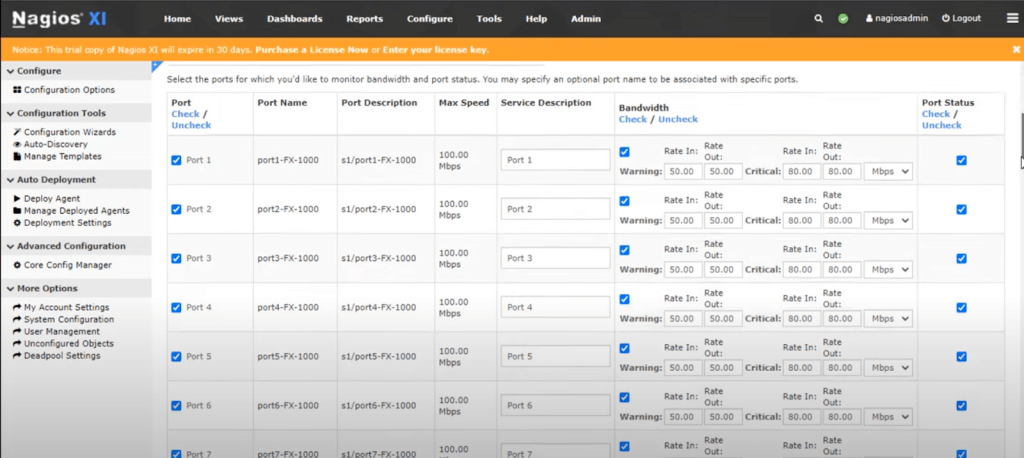
Nagios, a renowned player in the IT infrastructure monitoring space, offers a holistic view of your network environment. With its comprehensive feature set, it justifies its stance as the best solution for wide-ranging infrastructure oversight.
Why I Picked Nagios:
In evaluating various tools, I found Nagios to be exceptional due to its extensiveness and customization capabilities. I judged it as "Best for comprehensive infrastructure monitoring" primarily because it provides deep visibility into entire IT ecosystems. It monitors not only servers, applications, and services but also network protocols and system metrics, making it a powerhouse in infrastructure monitoring.
Standout features & integrations:
Nagios offers real-time updates and alerts, report generation, and predictive analysis, all essential features in effective network monitoring. The tool's capacity to customize checks and write plugins is also a significant plus. In terms of integrations, Nagios provides an extensive suite of options. It seamlessly links with popular incident management tools like PagerDuty and VictorOps, and also supports integration with popular scripting languages such as Perl and Python for custom plugin development.
Pricing:
The starting price for Nagios XI, the commercial version of Nagios, is $1,995 per instance (billed annually). This covers a single instance with no user restrictions and includes 1 year of support and maintenance.
Pros:
- Wide-ranging monitoring capability
- High level of customization
- Extensive integration possibilities
Cons:
- Steep learning curve for beginners
- Interface could be more modern
- Cost might be high for small businesses
2. Zabbix - Best for versatility in data collection methods
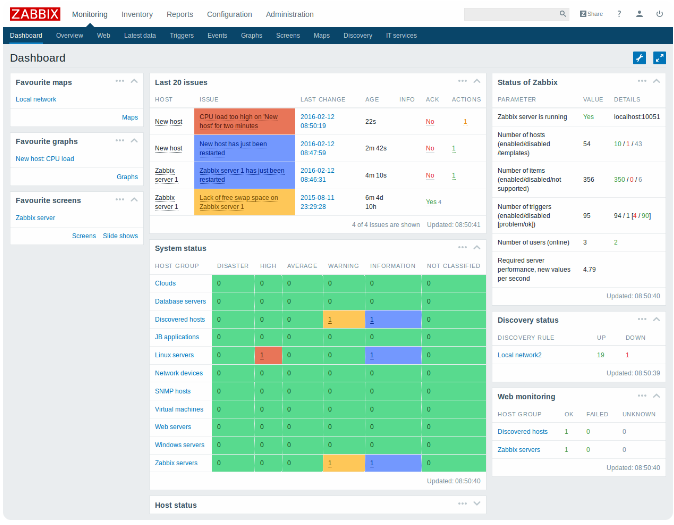
Zabbix emerges as a robust network monitoring software providing exceptional flexibility in data collection. With multiple data-gathering methods, it's primed to become the best fit for a variety of network scenarios.
Why I Picked Zabbix:
Upon meticulous comparison and analysis, I determined Zabbix as an optimal choice because of its flexible nature. With its vast array of data collection methods, such as JMX, SNMP, WMI, IPMI, or using custom scripts, this software allows for a fine-tuned approach to network monitoring. It stands out from the crowd and earns the title "Best for versatility in data collection methods" as it can adapt to virtually any monitoring needs - be it on-premise or cloud, regardless of the network's complexity.
Standout features & integrations:
Zabbix boasts a rich feature set, including trend prediction, automated problem resolution, anomaly detection, and more. One of the pivotal features is its high-level view with map navigation, which helps in understanding the network structure and dependencies.
Regarding integrations, Zabbix is compatible with numerous IT infrastructure components. It can work with databases like MySQL, PostgreSQL, and Oracle, cloud services such as AWS and Azure, as well as other monitoring tools like Grafana and Elasticsearch.
Pricing:
Zabbix follows an open-source model, so it's free to use. However, they offer paid technical support services. The starting price for their services is $1000 (billed annually).
Pros:
- Versatile data collection methods
- Scalable to large networks
- Open-source and cost-effective
Cons:
- Steeper learning curve
- GUI could be more intuitive
- Requires in-house expertise for setup and maintenance
3. ManageEngine OpManager - Best for integrated fault and performance management
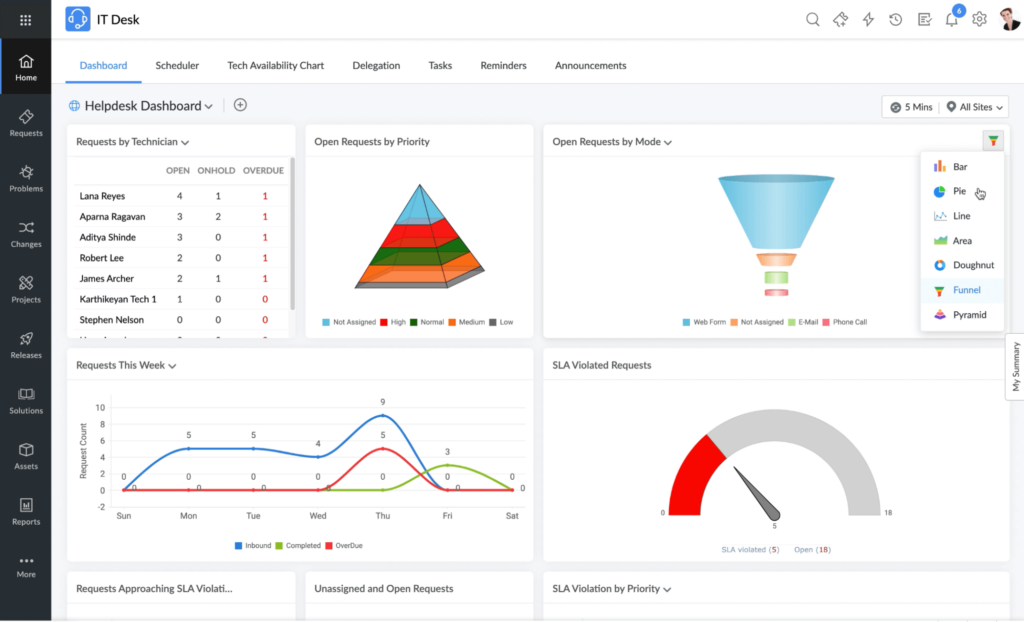
ManageEngine OpManager, a versatile network management software, offers a comprehensive toolset for integrated fault and performance management. With its ability to swiftly identify, notify, and rectify network issues, it truly shines in ensuring smooth network operations.
Why I Picked ManageEngine OpManager:
In selecting the optimal tools, ManageEngine OpManager emerged as a superior choice due to its fault and performance management integration. The reason I've chosen it as the "Best for integrated fault and performance management" is its ability to provide a comprehensive solution for detecting faults swiftly and managing overall network performance effectively.
It identifies network faults, sends notifications, and even automates workflows to rectify issues, making it a standout for efficient and proactive network management.
Standout features & integrations:
OpManager features include real-time network monitoring, customizable dashboards, intelligent alerting, and workflow automation, amongst others. Its NetFlow analyzer integration provides insight into bandwidth performance and traffic analytics. OpManager integrates well with other ManageEngine products, allowing you to build a unified IT management solution. It also supports integration with platforms such as Slack and Jira for improved collaboration and issue tracking.
Pricing:
The starting price for ManageEngine OpManager is $245 (billed annually) for managing 10 devices.
Pros:
- Integrated fault and performance management
- Good scalability for growing networks
- Detailed network visualization and mapping
Cons:
- UI can feel cluttered due to numerous features
- Initial setup may require technical expertise
- High cost for managing larger networks
4. PRTG Network Monitor - Best for intuitive setup with auto-discovery feature
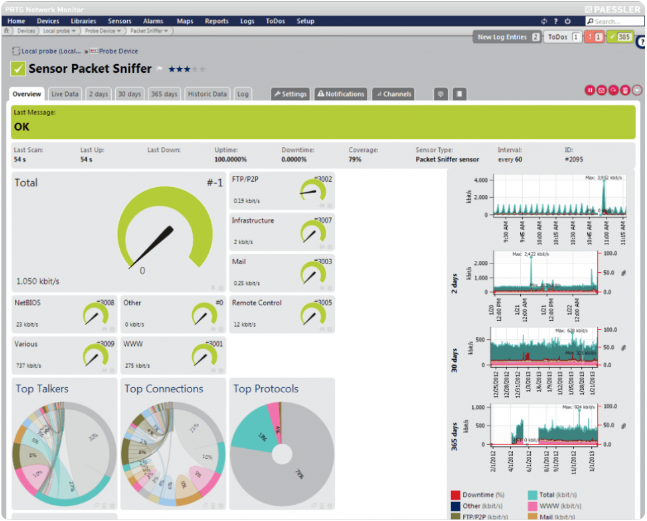
PRTG Network Monitor is a powerful, all-inclusive monitoring solution designed for networks of all sizes. Its most impressive feature is the intuitive setup, aided by the advanced auto-discovery function that rapidly identifies network devices.
Why I Picked PRTG Network Monitor:
When it comes to setting up network monitoring tools, the process can often be complex and time-consuming. But PRTG Network Monitor bucks the trend with its intuitive setup and exceptional auto-discovery feature.
I chose this tool as the "Best for intuitive setup with auto-discovery feature" because it simplifies the initial configuration process, automatically detecting and creating sensors for the discovered devices in your network. This standout capability reduces setup time and aids in delivering rapid insights.
Standout features & integrations:
PRTG Network Monitor offers comprehensive features, including flexible alerting, multiple user interfaces, cluster failover solutions, and more. The auto-discovery feature is particularly useful, rapidly identifying network devices and creating appropriate sensors. In terms of integrations, PRTG supports a vast array of technologies like SNMP, WMI, Flow technologies, and Packet Sniffing, enabling it to work seamlessly with various network devices and systems.
Pricing:
The pricing for PRTG Network Monitor starts from $1600 for 500 sensors (billed annually).
Pros:
- Rapid auto-discovery of network devices
- Intuitive setup and user-friendly interface
- Wide range of supported technologies for integration
Cons:
- High cost for managing larger networks
- Advanced features may require technical expertise
- No built-in ticketing system
5. Datadog - Best for cloud infrastructure monitoring and analytics
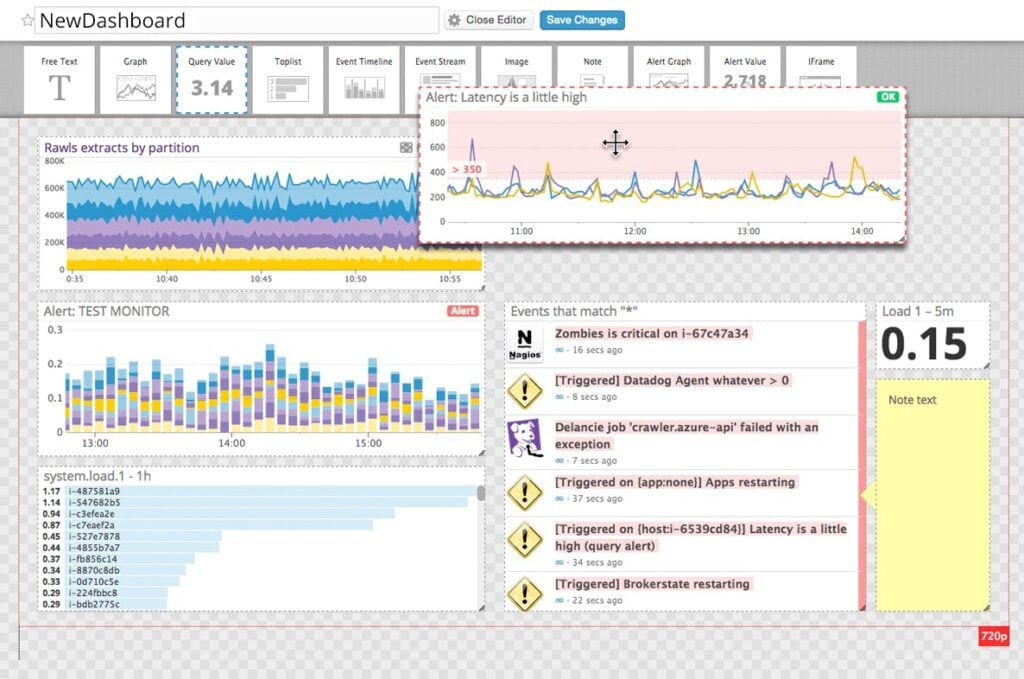
Datadog is a robust monitoring service for cloud-scale applications, providing businesses with observability into their entire infrastructure, from applications to the underlying hardware. Tailored primarily for cloud environments, it allows organizations to understand their systems' performance and derive insights from data analytics.
Why I Picked Datadog:
I selected Datadog for the list for its powerful, comprehensive, and well-structured platform that offers extensive cloud monitoring and analytics capabilities. The tool offers a unified view of an entire stack—apps, infrastructure, and cloud services. I chose this as the "Best for cloud infrastructure monitoring and analytics" because it brings together data from servers, containers, databases, and third-party services to make your stack observable in a single service.
Standout features & integrations:
Datadog comes with a plethora of features like real-time dashboards, anomaly detection, predictive analytics, and end-to-end request tracing to help you monitor your cloud infrastructure. It also offers seamless integration with other cloud services such as AWS, Google Cloud, Azure, and other tools like Slack, Jira, and PagerDuty, making it a versatile tool for modern, cloud-based organizations.
Pricing:
Datadog's pricing starts from $15 per host/month (billed annually).
Pros:
- Comprehensive cloud infrastructure monitoring
- Robust integrations with other services
- Powerful analytics tools
Cons:
- Costly for small businesses
- Requires a learning curve to utilize full features
- Some users report the need for better alert customization
6. Icinga - Best for its scalable and extensible architecture
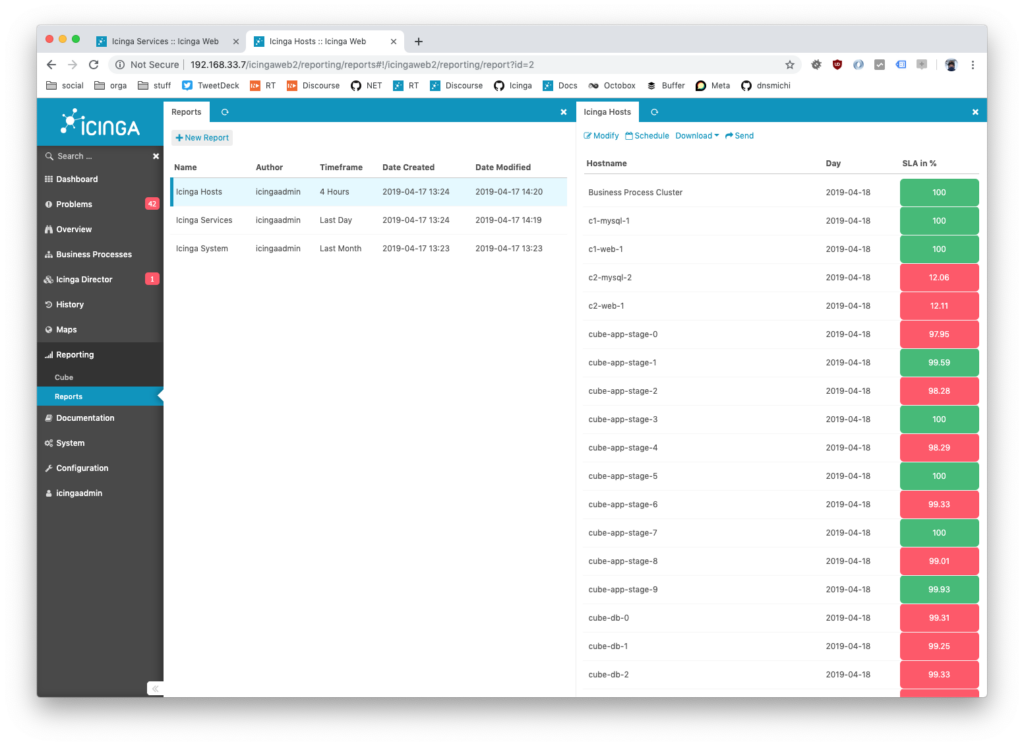
Icinga is an open-source network monitoring tool that offers flexible and scalable solutions to monitor network resources, notify users of outages, and provide data for reporting. It's known for its extensible architecture which makes it perfect for environments that need a customizable and scalable monitoring solution.
Why I Picked Icinga:
When selecting the tools for this list, Icinga caught my attention due to its highly scalable and customizable nature, capable of adapting to various network sizes and complexities. This adaptability, powered by its extensible architecture, is what makes it stand out.
I believe Icinga is "Best for its scalable and extensible architecture" due to the ease with which it accommodates the growth of an organization's network and its capacity to integrate with a multitude of plugins and add-ons for additional functionality.
Standout features & integrations:
Key features of Icinga include real-time network monitoring, notification via various channels, and customizable reporting. It offers a web interface for managing and visualizing network data, ensuring ease of use. Moreover, Icinga has strong integrations with tools like Graphite for metrics storage and visualization and Puppet for IT automation, allowing for a powerful and enhanced network monitoring experience.
Pricing:
Since Icinga is open-source, it's available for free. However, for enterprise-level features and support, Icinga offers commercial packages, and the pricing information for these can be obtained upon request.
Pros:
- Highly scalable and extensible
- Strong integration capabilities
- Open-source with enterprise-level support available
Cons:
- Requires technical knowledge for setup and customization
- Documentation could be improved
- Interface can feel outdated and less intuitive compared to competitors
7. Atera - Best for all-in-one RMM software for MSPs
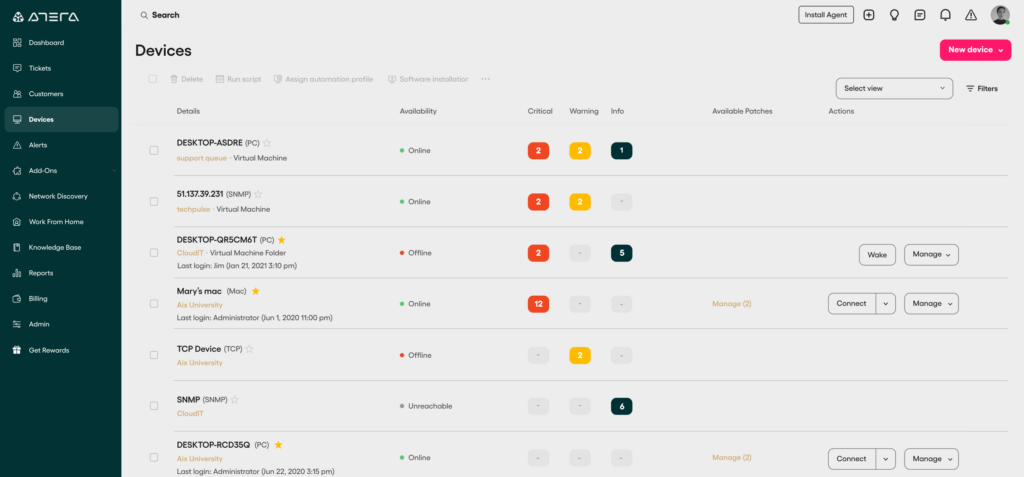
Atera provides a comprehensive remote monitoring and management (RMM) solution specifically designed for managed service providers (MSPs). It combines RMM, professional services automation (PSA), and remote access into a single powerful tool, making it ideal for MSPs who want to consolidate their toolset.
Why I Picked Atera:
In the process of choosing tools for this list, I found that Atera stood apart for its all-in-one approach. It offers RMM, PSA, and remote access in one platform, which simplifies the workflow for MSPs by removing the need for multiple separate tools.
I consider Atera the "Best for all-in-one RMM software for MSPs" because it provides a comprehensive suite of services that enable MSPs to efficiently monitor, manage, and support their clients' IT infrastructure.
Standout features & integrations:
Atera's standout features include its robust RMM capabilities for monitoring clients' IT environments, integrated PSA for efficient project management, and built-in remote access for quick support.
The tool also provides integrated IT automation, business reports, and billing and invoicing services. For integrations, Atera supports popular applications like QuickBooks, Splashtop, and TeamViewer, enhancing its functionality and ease of use.
Pricing:
Atera's pricing starts from $79/user/month (billed annually), making it a cost-effective choice for MSPs looking for an all-in-one solution. This price includes all the core features of the platform, with no additional costs for endpoints.
Pros:
- Consolidates RMM, PSA, and remote access into one tool
- Offers integrations with popular applications
- Provides a straightforward, per-user pricing model
Cons:
- Limited customization options compared to some competitors
- Lacks a few advanced features found in standalone RMM tools
- Some users report occasional software bugs
8. Spiceworks - Best for free network monitoring and helpdesk solution
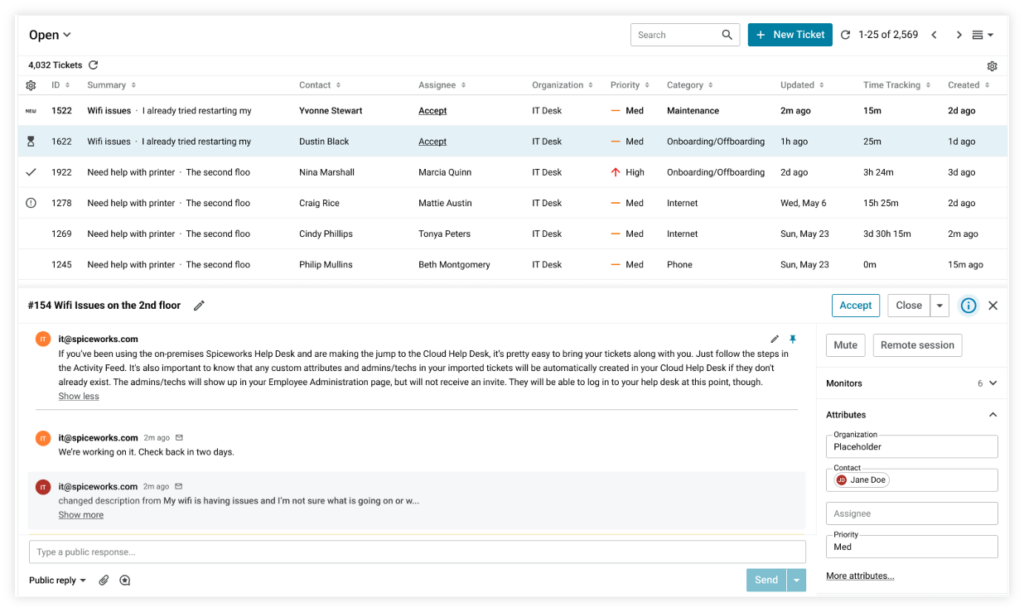
Spiceworks provides a combination of network monitoring and helpdesk solution. It offers tools for IT pros to discover, manage and troubleshoot network-related issues. With its robust and free offering, Spiceworks is an excellent choice for teams seeking a cost-effective way to manage their networks and helpdesk operations.
Why I Picked Spiceworks:
I selected Spiceworks for this list due to its comprehensive suite of tools available at no cost. Its feature set differentiates it from many paid counterparts, making it an exceptional offering in the marketplace.
I consider Spiceworks as the "Best for free network monitoring and helpdesk solution" because it provides critical network monitoring and helpdesk capabilities without the price tag, making it an ideal option for budget-conscious teams.
Standout features & integrations:
Key features of Spiceworks include network monitoring and troubleshooting, helpdesk ticketing, IT asset management, and a community forum for seeking advice and sharing knowledge. Its helpdesk solution integrates with your user directory to automatically pull in ticket information. As for integrations, Spiceworks supports a broad range of software, including Office 365, G Suite, and cloud-based applications.
Pricing:
One of the major advantages of Spiceworks is its pricing. It offers its full suite of network monitoring and helpdesk tools completely free.
Pros:
- Offers a comprehensive suite of tools at no cost
- Includes a community forum for sharing knowledge and advice
- Supports integration with many other software solutions
Cons:
- User interface may seem cluttered due to a multitude of features
- Performance issues have been reported with large networks
- The software is ad-supported, which might be distracting for some users
9. LogicMonitor - Best for hybrid IT monitoring from the cloud
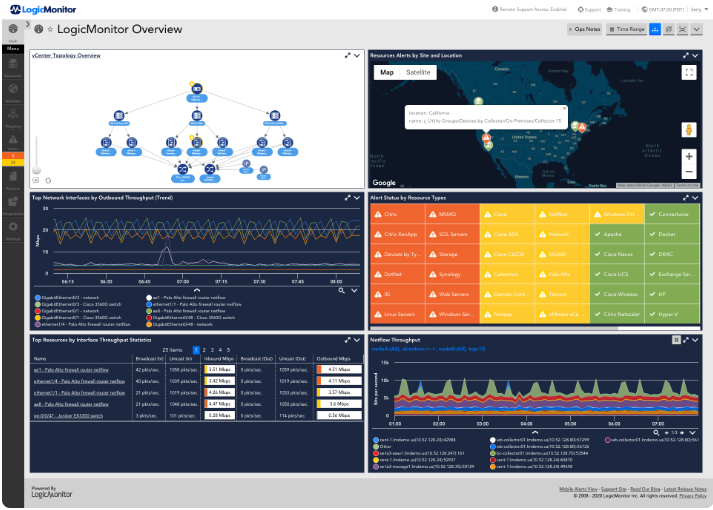
LogicMonitor is an automated SaaS-based infrastructure monitoring platform designed to help businesses monitor their hybrid IT environments. It provides an intuitive, cloud-based solution for monitoring and visualizing critical metrics, justifying its suitability for hybrid IT monitoring from the cloud.
Why I Picked LogicMonitor:
I picked LogicMonitor for its ability to provide a comprehensive view of hybrid IT environments. Its cloud-native nature and automation capabilities differentiate it, ensuring efficient monitoring. LogicMonitor stands out as the "Best for hybrid IT monitoring from the cloud" because it integrates seamlessly with on-premise, cloud, and hybrid infrastructure components, providing real-time, actionable insights.
Standout features & integrations:
LogicMonitor provides advanced features like auto-discovery, anomaly detection, and predictive analytics. It also offers out-of-the-box templates for various devices and applications. As for integrations, LogicMonitor supports a broad spectrum of cloud services and on-premise technologies, including AWS, Azure, Google Cloud, Oracle, and Cisco.
Pricing:
LogicMonitor's pricing starts from $15/device/month. Note that this is a starting price and the final cost can vary based on the specific configuration and needs of your IT environment.
Pros:
- Offers an automated, cloud-based platform for efficient monitoring
- Provides a comprehensive view of hybrid IT environments
- Supports a wide range of integrations
Cons:
- Can be pricey for smaller organizations
- Initial setup and customization might require technical expertise
- Some users have reported occasional lags in alert notifications
10. ScienceLogic - Best for AI-based IT operations and service management
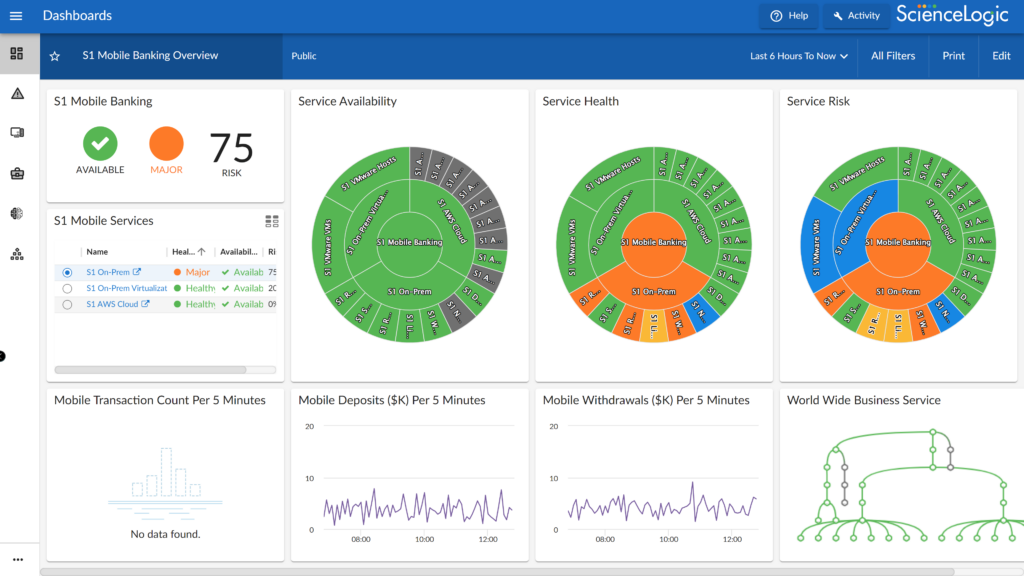
ScienceLogic is a platform that leverages AI to deliver advanced IT operations and service management capabilities. It provides a powerful solution for managing diverse IT environments, making it best suited for AI-based IT operations and service management.
Why I Picked ScienceLogic:
I chose ScienceLogic for its innovative use of AI in managing IT operations. What distinguishes it is its ability to automate complex IT tasks, turning data into actionable insights. In my view, ScienceLogic is "Best for AI-based IT operations and service management" due to its intelligent automation and service modeling capabilities that offer robust IT management and service optimization.
Standout features & integrations:
Key features of ScienceLogic include event management, dependency mapping, and SLA management. Its AI capabilities allow it to provide predictive insights and perform root cause analysis. As for integrations, ScienceLogic offers seamless connections with a range of systems and platforms such as AWS, Azure, Google Cloud, VMware, and more.
Pricing:
ScienceLogic's pricing information is not readily available; therefore, it falls under "Pricing upon request."
Pros:
- Employs AI for effective IT operations and service management
- Offers robust features like event management and dependency mapping
- Supports broad integrations with various systems and platforms
Cons:
- Pricing information is not transparent
- Might be complex to set up and require technical knowledge
- Some users reported the interface to be less intuitive
11. Zenoss - Best for unified monitoring of large-scale environments
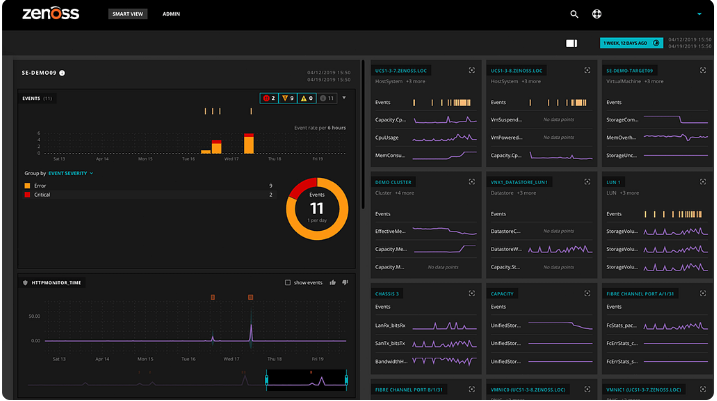
Zenoss provides a platform for IT monitoring, ensuring the health and performance of infrastructures. Its capacity for large-scale environments and comprehensive monitoring functionality make it the best choice for unified monitoring of large-scale environments.
Why I Picked Zenoss:
Zenoss emerged as a solid choice when it came to selecting a tool for managing vast IT infrastructures. Its extensive scalability and unified approach to monitoring set it apart. In my judgment, Zenoss excels as the "Best for unified monitoring of large-scale environments" owing to its extensive infrastructure coverage and the depth of its monitoring capabilities.
Standout features & integrations:
Zenoss includes features such as real-time analytics, capacity planning, and root cause analysis. It offers extensive integrations, including with public clouds like AWS, Azure, and Google Cloud, as well as with private cloud and virtualization technologies like VMware and OpenStack.
Pricing:
Zenoss' pricing is not disclosed upfront, so it falls under "Pricing upon request."
Pros:
- Scalable for large-scale environments
- Comprehensive monitoring features
- Extensive range of integrations
Cons:
- No transparent pricing available
- Can be complex to set up and configure
- Some users find it less user-friendly compared to similar tools
12. Opsview Monitor - Best for business service monitoring and reporting
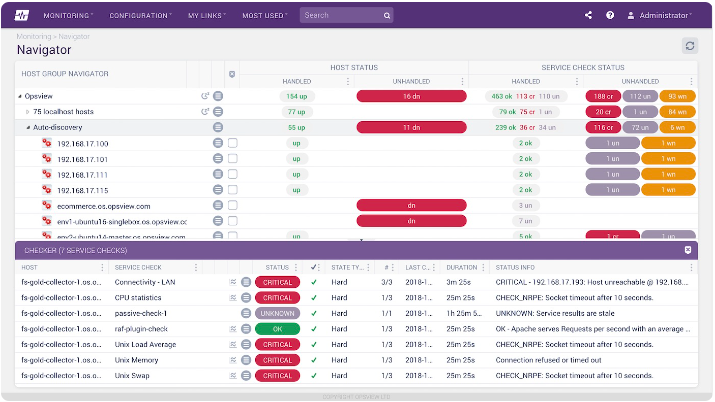
Opsview Monitor is an IT monitoring tool that focuses on business service monitoring and reporting. Its business-centric approach aligns IT functions with business outcomes, making it a top choice for business service monitoring and reporting.
Why I Picked Opsview Monitor:
I chose Opsview Monitor for its excellent capabilities in business service monitoring and reporting. Its business service centricity is unique, allowing users to align IT performance with business goals. Based on these features, I find Opsview Monitor to be the best fit for those needing a tool that excels in monitoring business services and delivering concise reports.
Standout features & integrations:
Opsview Monitor provides useful features such as business service monitoring, auto-discovery, and notifications. It also integrates well with popular tools like Slack, PagerDuty, and ServiceNow, providing seamless interoperability for diverse IT ecosystems.
Pricing:
Opsview Monitor pricing starts "From $5/user/month," and it is billed annually. The actual cost can vary based on the selected plan and the number of hosts monitored.
Pros:
- Strong emphasis on business service monitoring
- Good integration with communication and IT service management tools
- Detailed reporting capability
Cons:
- The user interface could be more intuitive
- Complex pricing structure based on the number of hosts
- Requires annual commitment for pricing
Other SolarWinds Alternative Tools
Below is a list of additional SolarWinds alternatives that I shortlisted but did not make it to the top 12. Definitely worth checking them out.
- Pandora FMS - Good for flexible, open-source monitoring of large environments
- Dynatrace - Good for AI-powered, full-stack observability
- SysAid - Good for combining IT service management and help desk needs
- ConnectWise Automate - Good for automated IT management and remote monitoring
- WhatsUp Gold - Good for network monitoring with visual interactive maps
- Sumo Logic - Good for cloud-native log management and analytics
- Grafana - Good for customizable data visualization and analytics
- Prometheus - Good for monitoring and alerting in Kubernetes environments
- New Relic - Good for real-time insights into application performance
- Elastic Stack (ELK Stack) - Good for powerful log analysis and search capabilities
- AppDynamics - Good for end-to-end business and application performance monitoring
- Sematext - Good for combining monitoring and logging with real-user monitoring
Selection Criteria
Having evaluated numerous IT monitoring tools, it's clear that there's a multitude of factors to consider when determining which platform is the most suitable.
The ideal software should not only provide in-depth monitoring but also feature a user-friendly interface and a comprehensive set of features tailored for specific needs. I've tested each of these tools personally, ensuring they meet a set of criteria that I consider critical when choosing an IT monitoring solution.
Core Functionality:
- Monitor and manage the health of IT infrastructure
- Analyze application performance and detect anomalies
- Provide real-time insights into system performance
- Automate alerts based on specific conditions
- Track and manage assets across the organization
Key Features:
- Scalability: Ability to handle increasing amounts of work in a capable manner or its potential to be enlarged in order to accommodate growth.
- Integration: The capability of the tool to integrate with various other software platforms that a company may use.
- Customizability: The tool should offer customization options to tailor it to the specific needs of the business.
- Comprehensive Reporting: Detailed reports highlighting key metrics and performance indicators are crucial.
Usability:
- Intuitive User Interface: IT monitoring tools should have an interface that allows easy navigation and operation, even for non-technical users. A clean design with well-organized, easy-to-find features enhances user experience.
- Quick Onboarding: The tool should provide an easy setup process. Guides, tutorials, or customer support to assist in getting started can be immensely helpful.
- Reliable Customer Support: Having access to a responsive, knowledgeable support team can save a lot of time and effort, especially when encountering technical difficulties or during the initial setup phase.
- Role-Based Access: In IT monitoring, different levels of access may need to be granted to different team members. The software should offer an easy way to manage and configure these access levels.
People Also Ask (FAQs)
What are the benefits of using these SolarWinds alternatives?
There are several benefits to using these SolarWinds alternatives:
- Enhanced Security: Many of these tools come with robust security measures to protect against threats and data breaches.
- Cost Efficiency: Often, these alternatives provide similar features at a lower cost.
- Scalability: Most of these tools are designed to scale your business, accommodating growth without performance degradation.
- User-friendly: These alternatives often have intuitive interfaces and user-friendly dashboards for easy navigation and use.
- Integration Capabilities: These tools can seamlessly integrate with other software platforms used by the company, ensuring a unified IT environment.
How much do these SolarWinds alternatives cost?
The cost of these SolarWinds alternatives varies significantly, depending on the features, scalability, and level of support they offer.
What are the typical pricing models for these tools?
The typical pricing models for these tools can be subscription-based, which can either be monthly or annually. Some tools also have a one-time licensing fee, particularly for on-premise versions.
What is the typical range of pricing for these SolarWinds alternatives?
The pricing can range anywhere from $20 per user per month to $150 per user per month, depending on the tool and the features it offers.
Which are the cheapest and most expensive software?
The cheapest software can start as low as $20 per user per month, like Zabbix, while the more expensive ones, like AppDynamics, can cost up to $150 per user per month.
Are there any free SolarWinds alternatives?
Yes, there are free SolarWinds alternatives like Nagios and Zabbix, which offer free versions of their tools. However, the free versions may have limited features compared to their premium counterparts.
Do these alternatives offer trial periods?
Most of these SolarWinds alternatives offer trial periods, which typically last between 14 to 30 days. This allows you to test the tool's features and usability before committing to a purchase.
How do these SolarWinds alternatives ensure data security?
These alternatives often have robust security measures in place, such as encryption, role-based access control, and regular audits, to ensure data security. Some also comply with various industry standards to further enhance their security framework.
Related IT Management Software Reviews
Summary
In conclusion, selecting the best SolarWinds alternative necessitates a clear understanding of your own specific requirements and how these align with the features and capabilities offered by various IT monitoring solutions.
- Consider your Environment: Remember to factor in the specific needs of your IT infrastructure. Whether you have a small-scale environment or a large-scale one, a hybrid or a cloud-native infrastructure, there's a tool out there perfectly suited for your requirements.
- Evaluate Core Functionalities and Features: It's essential to focus on the tool's ability to deliver robust monitoring, alerting, and reporting capabilities. AI-driven operations, predictive analytics, and service management functionalities could greatly enhance your IT monitoring effectiveness.
- Don't Overlook Usability and Pricing: A complex tool with a steep learning curve might not be the best choice for a small team. Look for intuitive, user-friendly platforms that align with your budget. Even if a tool offers advanced features, it won't be of much use if the tool itself is difficult to navigate. Additionally, ensure to choose a tool with transparent and flexible pricing.
Choosing the right IT monitoring solution can significantly streamline your operations, enhance performance, and ultimately ensure smoother, more reliable experiences for your end users.
What Do You Think?
As the IT monitoring landscape continues to evolve, I’m always eager to learn about other impressive tools. If you have any suggestions for SolarWinds alternatives that you believe should have made this list, please feel free to share them. Your insights and experiences are invaluable to me and other readers, and I'd love to hear from you.
